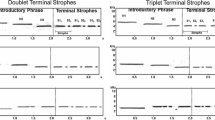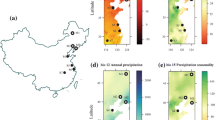Abstract
Birdsong evolution has influenced by various ecological and social factors. When related species that sing similar songs coexist, the acoustic properties of the songs of one or both species may shift, and the songs may diverge. We investigated geographic variation in the songs of the Japanese tit (Parus minor) and the varied tit (Poecile varius) in the Ryukyu Archipelago, Japan, whose islands harbor either one or both species. The songs of the two species exhibited similar structure, but acoustic measurements differed between them. For example, varied tits sang songs at higher frequency than Japanese tits did. The songs of both species varied geographically. At sites with higher relative densities of varied tits, Japanese tits sang lower frequency songs, indicating that in areas of coexistence, Japanese tits sang songs that had acoustically diverged from those of varied tits. Song variation in varied tits was not related to sympatry with Japanese tits. These asymmetric results suggest that the subordinate Japanese tit modified the acoustic characteristics of its song to avoid harassment by the dominant varied tit. We observed no effects of genetic divergence or local intraspecific density on Japanese tit or varied tit songs. This study used geographic variation to examine hypotheses of song evolution, and the results highlight the importance of character displacement.







Similar content being viewed by others
References
Acevedo P, Melo-Ferreira J, Real R, Alves PC (2012) Past, present and future distributions of an Iberian endemic, Lepus granatensis: ecological and evolutionary clues from species distribution models. PLoS One 7, e51529. doi:10.1371/journal.pone.0051529
Baker MC (1996) Depauperate meme pool of vocal signals in an island population of singing honeyeaters. Anim Behav 51:853–858
Brumm H, Todt D (2004) Male–male vocal interactions and the adjustment of song amplitude in a territorial bird. Anim Behav 67:281–286
Catchpole CK (1987) Bird song, sexual selection and female choice. Trends Ecol Evol 2:94–97
Catchpole CK (1980) Sexual selection and the evolution of complex songs among European warblers of the genus Acrocephalus. Behaviour 74:149–165
Catchpole CK, Slater PJB (1995) Bird song: biological themes and variations. Cambridge University Press, Cambridge
Clement M, Posada D, Crandall KA (2000) TCS: a computer program to estimate gene genealogies. Mol Ecol 9:1657–1659
Cody ML (1969) Convergent characteristics in sympatric species: a possible relation to interspecific competition and aggression. Condor 71:222–239
Dingle C, Poelstra JW, Halfwerk W, Brinkhuizen DM, Slabbekoorn H (2010) Asymmetric response patterns to subspecies-specific song differences in allopatry and parapatry in the gray-breasted wood-wren. Evolution 64:3537–3548
Doutrelant C, Lambrechts MM (2001) Macrogeographic variation in song—a test of competition and habitat effects in blue tits. Ethology 107:533–544
DuBois AL, Nowicki S, Searcy WA (2009) Swamp sparrows modulate vocal performance in an aggressive context. Biol Lett 5:163–165
Excoffier L, Lischer HEL (2010) Arlequin suite ver 3.5: a new series of programs to perform population genetics analyses under Linux and Windows. Mol Ecol Resour 10:564–567
Fujii T (1975) A cavity nester, the varied tit. In: Haneda K (ed) Life of wild birds. Tsukiji-shokan, Tokyo, pp 60–63
Grant PR (1972) Convergent and divergent character displacement. Biol J Linn Soc 4:39–68
Grant BR, Grant PR (2010) Songs of Darwin’s finches diverge when a new species enters the community. Proc Natl Acad Sci U S A 107:20156–20163
Hamao S, Sugita N, Nishiumi I (2013) Geographical variation in mitochondrial DNA and vocalizations in two resident bird species in the Ryukyu Archipelago, Japan. Bull Natl Mus Nat Sci Ser A 39:51–62
Hamao S, Watanabe M, Mori Y (2011) Urban noise and male density affect songs in the Great Tit Parus major. Ethol Ecol Evol 23:111–119
Hultsch H, Todt D (2004) Learning to sing. In: Marler, Slabbekoorn H (eds) Nature’s music, the science of birdsong. Elsevier Academic Press, Amsterdam, pp 80–107
Kokko H, Rankin DJ (2006) Lonely hearts or sex in the city? Density-dependent effects in mating systems. Phil Trans R Soc B 361:319–334
Kroodsma DE (1985) Geographic variation in songs of the Bewick’s wren: a search for correlations with avifaunal complexity. Behav Ecol Sociobiol 16:143–150
Kroodsma DE, Miller EH (eds) (1996) Ecology and evolution of acoustic communication in birds. Cornell University Press, Ithaca
Miller EH (1982) Character and variance shift in acoustic signals of birds. In: Kroodsma DE, Miller EH, Ouellet H (eds) Acoustic communication in birds, vol 1. Academic Press, New York, pp 253–295
Mihara M, Ohsako Y (1994) Species and frequency visiting a feeding table, and dominant-subordinate relationship among Tits on Shinmei Hill. Ciconia (Fukui Nature Conservation Center Reports) 3:27–38
Momose H (2000) Neighbour-stranger recognition based on song in the Japanese bush warbler (Cettia diphone). Mem Fac Sci Kyoto Univ (Ser Biol) 17:25–32
Nakamura T, Nakamura M (1995) Bird’s life in Japan with color pictures—birds of mountain, woodland and field. Hoikusya, Ohsaka
Numata M, Iwase T (1975) The vegetation of Japan. Asakura-shoten, Tokyo
Payne RB (1986) Bird songs and avian systematics. In: Johnston R (ed) Current ornithology. Plenum Press, New York, pp 87–126
Pfennig DW, Pfennig KS (2010) Character displacement and the origins of diversity. Amer Natur 176(suppl):S26–S44
Qvarnström A, Haavie J, Sæther SA, Eriksson D, Pärt T (2006) Song similarity predicts hybridization in flycatchers. J Evol Biol 19:1202–1209
R Core Team (2014) R: A language and environment for statistical computing. R Foundation for Statistical Computing, Vienna, Austria. URL http://www.R-project.org/
Saitoh T, Sugita N, Someya S, Iwami Y, Kobayashi S, Kamigaichi H, Higuchi A, Asai S, Yamamoto Y, Nishiumi I (2015) DNA barcoding reveals 24 distinct lineages as cryptic bird species candidates in and around the Japanese Archipelago. Mol Ecol Resour 15:177–186
Slabbekoorn H, Smith TB (2002) Bird song, ecology and speciation. Phil Trans R Soc B 357:493–503
Takano S (1980) Handbook for identification of Japanese birds. Wild Bird Society of Japan, Tokyo (In Japanese)
Tamura K, Stecher G, Peterson D, Filipski A, Kumer S (2013) MEGA6: molecular evolutionary genetics analysis version 6.0. Mol Biol Evol 30:2725–2729
The Ornithological Society of Japan (2012) Check-list of Japanese birds, 7th revised edition. The Ornithological Society of Japan, Sanda
Wallin L (1986) Divergent character displacement in the song of two allospecies: the pied flycatcher Ficedula hypoleuca, and the collared flycatcher Ficedula albicollis. Ibis 128:251–259
Yamashina Y (1934) A natural history of Japanese birds, vol 1. Iwanami-shoten, Tokyo
Zink RM, Dittmann DL (1993) Gene flow, refugia, and evolution of geographic variation in the song sparrow (Melospiza melodia). Evolution 47:717–729
Acknowledgments
We thank T. Mizuta, H. Torikai, and the Amami Wildlife Conservation Center for their help in the field. Genetic analyses were supported by the staff of the Center for Molecular Biodiversity Research, National Museum of Nature and Science, Tokyo. Two anonymous reviewers provided helpful comments on the manuscript. This study was financially supported by the National Museum of Nature and Science (project “Integrated Research on Biodiversity of Interspecies Relationships”) and a JSPS Grant-in-Aid for Scientific Research (C) (No. 24570119).
Author information
Authors and Affiliations
Corresponding author
Rights and permissions
About this article
Cite this article
Hamao, S., Sugita, N. & Nishiumi, I. Geographic variation in bird songs: examination of the effects of sympatric related species on the acoustic structure of songs. acta ethol 19, 81–90 (2016). https://doi.org/10.1007/s10211-015-0228-6
Received:
Revised:
Accepted:
Published:
Issue Date:
DOI: https://doi.org/10.1007/s10211-015-0228-6




